
Greenlee County, the fourteenth and youngest county in
Arizona, was organized from the eastern part of Graham County, the organization
having become effective January 1, 1911. Greenlee is one of the richest and most
populous counties of the State. Its last assessment showed a valuation of
upwards of $12,000,000, with vast improvements and developments under way,
especially by the mining companies operating there. Three of the greatest mining
companies of the State, The Arizona Copper Company, The Detroit Copper Mining
Company, and The Shannon Copper Company, have their holdings in Greenlee County.
Although primarily a mining county, a large number of cattle are raised in
Greenlee County, and this industry is being gradually developed. There is also a
large amount of land under cultivation, and in the southern part are many fine
ranches, on which alfalfa hay, grain, fruit and vegetables are raised, and for
the latter the towns of Clifton and Morenci furnish an excellent market. The
Arizona Copper Company has stores in both these places, and The Phelps Dodge
Mercantile Company has a store at Morenci that will compare favorably with those
found in large cities. Other good stores are to be found throughout the county,
and the banking facilities are splendid. There are also two live newspapers, The
Copper Era and The Duncan Arizonan.
For the transportation of ore from
mines to smelter the Shannon Copper Company has built, at a greater cost per
mile than any other road in the State, a railroad 13 miles long, and the
Coronado Railroad, owned by The Arizona Copper Company, connects the towns of
Metcalf and Clifton. The Arizona & New Mexico Railway also passes through the
county and connects with the Southern Pacific main line.
Clifton, the county seat, has a population of
more than 5,000, and is situated on the line of the Coronado and Arizona & New
Mexico Rys. Morenci, the next town of importance in the county, has also a
population of more than 5,000. Both these towns are dependent upon the mining
and smelting; of copper, and both have excellent lighting, water and telephone
systems, all modern conveniences, and splendidly equipped high schools, with
superior opportunities for education. Each one also supports a Catholic and a
Presbyterian church, two banks, two good hotels, and two hospitals, the latter
maintained by the mining companies whose headquarters are in the county. These
towns are seven miles apart, and arrangements have been made by the corporation
which recently received the franchise for an electric road between Globe and
Miami, to build an electric road connecting them within the next year.
Metcalf, another thriving town of more than 2,000 inhabitants, is situated six
miles from Clifton on the Coronado Railway, in the heart of the mining district,
and upon this industry its inhabitants are largely dependent. Duncan is the
largest town in the farming district and the shipping point for the farmers and
cattlemen of a large area. It has a thoroughly good school system, hotel, bank,
several stores and weekly paper. Plans are now under way for a highway from
Duncan, on the A. & N. M., to Solomonsville on the A. E. Ry.
Greenlee
County needs better transportation facilities, and her people are working
earnestly for better highways. The affairs of the county are handled by capable
officials, its outlook is bright, and the desirability of Greenlee as a place of
residence is constantly being recognized by persons in search of a permanent
home.
Arizona Copper Company, LTD., whose lands consist of about 4,000 acres
containing eight producing mines in Greenlee County, was organized in August,
1884, under the laws of Great Britain, with a capitalization of 755,000. About
20 per cent of this stock is issued in the United States. The mines, except the
Coronado, are developed to a depth of 500 feet only, being opened mainly by
tunnels, thereby affording cheap extraction. Notwithstanding the comparatively
shallow zone of development, a tremendous amount of ore is in sight.
Considerable diamond drilling has been done. The Humboldt mine, which is the
principal producer, shows a large body of low-grade disseminated chalcocite.
Extraction from this property is partly opencast, but mainly through tunnels
equipped with electric lights and electric traction. The haulage system uses the
overhead trolley. Electric locomotives of 12 horse-power haul 80-ton loads, the
line having a single track running 8,600 feet directly through the mountain,
with a loop reaching all workings of the Humboldt mine, the tunnel running
through International Hill direct to the new concentrator. The Longfellow mine,
belonging to this Company, is the oldest important copper mine in Arizona,
dating from about 1877. A 1300-foot tunnel driven from Chase Creek connects with
a 600-foot blind shaft, obviating about three miles of railroad haulage over bad
grades. The Longfellow Extension mine has developed into a good property.
The Coronado Group, about nine miles from Clifton, has three shafts, the
deepest of which is 1,100 feet, and shows considerable high grade ore. Ore is
taken from the different mines by six gravity tramlines to storage bins on the
Coronado railroad, from which it is hauled to the reduction plant at Clifton.
This railroad is of 36-inch gauge from Clifton to Metcalf, a distance of seven
miles, and has 30-ton ore cars.
The mines and works use about 3,000
horse-power, supplied in about equal portions from steam, gas and distillate
engines. The gas-engine plant is exceptionally complete. It has been planned to
develop hydro-electric power and transmit same from a dam about 50 miles
distant. The somewhat scattered works at Clifton, Morenci, Longfellow and
Metcalf were remodeled and enlarged several times, and the reduction plants now
include six concentrators, a smelter, lixiviation plant and acid plant.
No. 6 Concentrator has a daily capacity of 1 ,500 tons, and has two 600-ton
crushers and a 250 horse-power Nordberg engine, direct connected to a 125
horse-power dynamo, steam being furnished by three 400 horse-power Stirling
water-tube boilers. No. 6 Mill has a large settling basin. The Company has had
trouble over tailings and has found it necessary to use its best endeavors to
keep its tailings from entering the river. There is a tank about a mile above
the town, with an 18-inch wooden pipe line to supply clear water at flood times,
and in dry seasons, the tank being fed by seepage and spring water.
The
smelter is of steel frame with slate roof and floor of iron plates laid in
cement. There are six 300-ton water-jacket blast furnaces, each 39x240 feet at
the tuyeres, with blast supplied by Nos. 7, 9 and 10 Connersville blowers,
operated by a 275 horse-power engine. Gases from the blast furnaces pass through
a 480-foot tunnel and 300-foot stack. Matte of 50 to 55 per cent copper tenor is
charged into the converters by a 10-ton ladle handled by a 30-ton electric
crane. The converter plant has three stands and six 7-ton shells, with a daily
capacity of 50 tons of 99.5% blister copper. Disintegration of slag by running
water was tried, but has been discontinued, and molten slag is again handled by
a steam locomotive. A complete new smelter is now under construction.
The
25-ton briquetting plant uses coal-breeze as a binder, under a pressure of 2,000
pounds per square inch. The plant is entirely automatic, fines going in at one
end and briquettes being loaded on cars at the other.
The acid plant
makes about 3,000 tons of sulphuric acid yearly from the fumes of the roasters,
the entire product being used in the leaching plant, which treats an average of
250 tons of low grade oxidized ore daily. This is perhaps the most successful
leaching plant in the United States.
Miscellaneous enterprises include a
well-equipped foundry, machine shop, saw mill, planing mill, and 20-ton ice
plant, all built of brick. The Company also has excellent general merchandise
stores at Clifton, Longfellow and Metcalf, while a splendid library is
maintained for employees. The number of employees at the present time is over
2,700.
The office of the Company is at 29 St. Andrew Square, Edinburgh,
Scotland, and the mine and works office at Clifton, Arizona. The officers are as
follows: John Wilson, Chairman ; P. Dickson, J. P. G. Readman, J. Wilson, Y. J.
Pentland, Alex McNab, J. P., and Lord Salveson, Directors ; Norman Carmichael,
General Manager ; William Exley Miller, Secretary; George Fraser, Smelter
Superintendent; Archibald Morrison, Mill Superintendent at Clifton; J. G.
Cooper, Purchasing Agent. The Company is entitled to much credit for its
conservatism and the thoroughly successful working of its plant.
Shannon Copper Company's Mines and Smelter
The Shannon Copper Co. was organized November 13, 1899, under the laws of Delaware,
for the purpose of purchasing the Hughes and Shannon mine, which had been for
years considered the equal of any copper mine in Arizona. It had been owned for
twenty years by Charles M. Shannon, the well known pioneer of the district, who
had been unable to interest capital to develop the property so as to bring it to
a producing stage, until he attracted the attention of Mr. W. B. Thompson, of
Boston. Mr. Thompson, however, would not undertake to handle the property unless
it w y as sold outright, which Air. Shannon agreed to do with the understanding
that he be allowed to retain an interest in the company as stockholder. The
company was capitalized at $3,000,000, par value of shares $10; and in July,
1909, this amount was increased to $3,300,000, of which $300,000 was held in the
treasury for conversion of an issue of $600,000 6% bonds which had been
authorized in May, 1909, by the Shannon-Arizona Railway Company, and were
convertible into Shannon stock at $20.00. The company also had a direct issue of
7% bonds originally $600,000 with a $60,000 annual sinking fund for redemption,
by means of which the bond issue was reduced. The new company immediately began
the systematic development of the property, and shortly afterward purchased some
adjoining claims from the Arizona Copper Company, the pioneer mining company of
the district. This gave them not only very valuable mines, but also control of
ground which was necessary in the extensive work which had been mapped out.
Their lands now consist of about 50 claims, in area about 400 acres, at Metcalf,
in the Greenlee district, with a millsite of about 100 acres area, and some
limestone claims on the Frisco River. The mine is developed by shafts, tunnels
and open pits, underground workings reaching a depth of about 1,300 feet below
the crest of the mountain. The mine is timbered with 12x12" square sets.
Extraction is by two double track tunnels, one of which is 7x8' in size and
connects with a 1,400' double-track incline tram leading to the Coronado
Railway, with six ore-bins at either end, the tramway, inclined at 36 deg.,
having 10-ton cars operating in counter-balance with a retarding engine at the
upper end, the steel cable passing around a 13' double drum, which runs a small
air-compressor that generates power while serving as an auxiliary brake. The
Shannon Company controls the Coronado Mining Co., through ownership of 51%, of
the stock issue, and operates under lease, the property of the Leonard Copper
Company, owning the Copper Belle mine at Gleeson. They also own and operate the
Shannon-Arizona Railway, which is capitalized at $600, 000. This standard-gauge
line of about ten miles length, was built and equipped at a cost of about
$600,000, the territory traversed being very rugged and a 900-foot tunnel having
been necessary. It was completed in 1910, and has not only proven a saving to
the company of considerable money on ore haulage, but gives immunity from the
serious interferences formerly caused by annual floods.
The 1,000-ton
smelter at Clifton, seven miles from the mines, had two 350-ton water-jacket
blast-furnaces, which were thrown into one large furnace by a new section
between, built on the plan first used at the Washoe works, making a single
blast-furnace of 1,000 tons daily capacity. The briquetting plant for flue dust
and fines has a daily capacity of 60 tons, and there is a small sampling mill in
connection. The 500-ton concentrator, on the San Francisco River, eight miles
from the mine, has ore bins 100' long, in two sections, for first and second
grade ores, and treats daily about 400 tons of ore.. Tailings have carried as
high as 1.2% copper, due to the highly oxidized condition of ores, but have been
stored and may be leached later. Formerly there was much trouble from acid
waters eating the iron screens, while brass or copper screens in the jigs were
worn out too rapidly by abrasion. This trouble was overcome by a simple but
ingenious application of the principle of electrolysis, a low-voltage electric
current being applied to the jigs, by which the screen became a cathode in the
circuit, this attracting hydrogen from the water, which in turn, attracts the
metallic salts, and the copper freed is deposited on that portion of the screens
formerly eaten away. Water is pumped from wells near the San Francisco River by
an electric triplex pump. The amount of ore smelted has shown an unbroken annual
increase since the fiscal year 1904, while costs have also shown improvement The
office of the company is at No. 82 Devonshire Street, Boston, Mass., the mine
office at Metcalf, Arizona, and the works office at Clifton, Arizona. The
officers are: Nathan L. Amster, president; Alexander B. Clough, vice president;
David A. Ellis, secretary; R. Townsend McKeever, treasurer; Charles R. Jeffers,
assistant secretary and treasurer; John W. Bennie, general manager; H. H. Dyer,
general superintendent; H. A. Collin, mine superintendent; William H. Bond, mill
superintendent. The stock of the company is listed on the Boston Stock Exchange,
the property is considered very valuable, and the management excellent.
The First National Bank of Clifton was
organized in 1901. Its capital is $30,000, which is fully paid, and while this
bank does not rank among the large institutions of Arizona, it does rank
foremost among the soundest. Its management is able and experienced, and its
directorate and stockholders are found among some of the leading business and
professional men of that section. E. M. Williams, president, is also one of the
founders and a charter director. As general manager of the Arizona Copper
Company store, he is known through-out the state as a responsible business man.
Henry Hill, vice president, is a well known business man of Clifton. W. J.
Riley, cashier, is also director of the State Bank of Morenci and the Bank of
Duncan, and since he has grown to manhood, has been almost continuously employed
in banking, while J. J. Kelly, assistant cashier, is a native of the state, and
has grown up in the banking business, and although a young man has attained to
prominence in banking circles.
The board of directors consists of the
foregoing officials, together with John R. Hampton, vice president of the Valley
Bank, Phoenix, George Frazer, John Webster, J. T. McClay, C. O. Billingsley, and
Sam Abraham, proprietor of the Clifton Hotel.
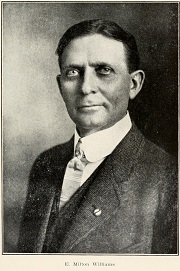 E. MILTON WILLIAMS, president of the First National Bank of Clifton, and general manager
of the Arizona Copper Company store, is well known in commercial and financial matters
generally. He was one of the founders; and a charter director of the bank, which
opened for business May 14, 1901. Mr. Williams was born October 26, 1862, in
Rockford, Ala., and reared in that state. Having graduated from high school, he
took a course in the Agricultural & Mechanical College, at Auburn, was graduated
in 1883, and for ten years was employed in commercial life in the vicinity of
his home. He then decided to try his fortunes further west and has spent some
time in Chicago, Denver, and the State of Washington. In 1893 he came to Arizona
to accept a position as salesman in the dry goods department of the Arizona
Copper Company store at Clifton, and in 1897 he was made manager of the Morenci
branch of this store, and later general manager of the department stores of the
company, in charge of all three of their houses. In each capacity in which he
has served affairs under his jurisdiction have shown the results of ability and
thoroughness. Air. Williams is a stockholder in the Arizona Copper Company and
one of the most substantial and well known men of affairs in that section of
Arizona. Fraternally he is a member of the Masons and Elks, and politically is a
Democrat, but with no aspirations to office, although at the instance of his
friends, he served one term in the Territorial Legislature. Mr. Williams was
married November 14, 1900, to Miss Margaret Lee Harris, daughter of Judge George
Harris, of San Saba, Texas.
E. MILTON WILLIAMS, president of the First National Bank of Clifton, and general manager
of the Arizona Copper Company store, is well known in commercial and financial matters
generally. He was one of the founders; and a charter director of the bank, which
opened for business May 14, 1901. Mr. Williams was born October 26, 1862, in
Rockford, Ala., and reared in that state. Having graduated from high school, he
took a course in the Agricultural & Mechanical College, at Auburn, was graduated
in 1883, and for ten years was employed in commercial life in the vicinity of
his home. He then decided to try his fortunes further west and has spent some
time in Chicago, Denver, and the State of Washington. In 1893 he came to Arizona
to accept a position as salesman in the dry goods department of the Arizona
Copper Company store at Clifton, and in 1897 he was made manager of the Morenci
branch of this store, and later general manager of the department stores of the
company, in charge of all three of their houses. In each capacity in which he
has served affairs under his jurisdiction have shown the results of ability and
thoroughness. Air. Williams is a stockholder in the Arizona Copper Company and
one of the most substantial and well known men of affairs in that section of
Arizona. Fraternally he is a member of the Masons and Elks, and politically is a
Democrat, but with no aspirations to office, although at the instance of his
friends, he served one term in the Territorial Legislature. Mr. Williams was
married November 14, 1900, to Miss Margaret Lee Harris, daughter of Judge George
Harris, of San Saba, Texas.
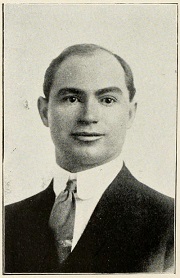 WILLIAM J. RILEY, cashier of The First
National Bank of Clifton, is well known throughout Arizona financial circles, as
he is also a director of the State Bank of Morenci and of the Bank of Duncan. He
is the son of Francis S. and Frances Webb Riley, of San Diego, and in the latter
city he was born and educated. Having completed a commercial course, his first
position was as bookkeeper in a bank in San Diego. On coming to Arizona, Mr.
Riley located in Yurra, where he was employed in a bank, and soon became as well
known in the political as in the business life. During his residence there he
served a term as Deputy County Recorder of the County. In 1904 he went to
Clifton to accept a position with The First National Bank, was promoted to the
place of assistant cashier, and after three years service to his present
position. In addition to his banking associations, Mr. Riley is interested in
various enterprises of a different nature, and is secretary and treasurer of
Clifton Lumber and Improvement Company. He has also served a term as city
treasurer. He is a member of the Masons, and Master of Clifton Lodge, and is
treasurer of Clifton Lodge No. 1174 B. P. O. E. Mr. Riley married Miss Jessie C.
Cummins, and they have one child, Frances E.
WILLIAM J. RILEY, cashier of The First
National Bank of Clifton, is well known throughout Arizona financial circles, as
he is also a director of the State Bank of Morenci and of the Bank of Duncan. He
is the son of Francis S. and Frances Webb Riley, of San Diego, and in the latter
city he was born and educated. Having completed a commercial course, his first
position was as bookkeeper in a bank in San Diego. On coming to Arizona, Mr.
Riley located in Yurra, where he was employed in a bank, and soon became as well
known in the political as in the business life. During his residence there he
served a term as Deputy County Recorder of the County. In 1904 he went to
Clifton to accept a position with The First National Bank, was promoted to the
place of assistant cashier, and after three years service to his present
position. In addition to his banking associations, Mr. Riley is interested in
various enterprises of a different nature, and is secretary and treasurer of
Clifton Lumber and Improvement Company. He has also served a term as city
treasurer. He is a member of the Masons, and Master of Clifton Lodge, and is
treasurer of Clifton Lodge No. 1174 B. P. O. E. Mr. Riley married Miss Jessie C.
Cummins, and they have one child, Frances E.
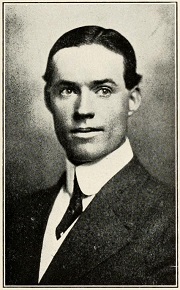 J. J. KELLY, assistant
cashier of the First National Bank of Clifton, although one of the youngest, is
one of the best known bankers in the state, and no doubt enjoys as wide an
acquaintance among the financiers of the Southwest as any banker in Arizona. He
began his business life in a bank and has gradually advanced from minor
positions to the one he now holds. His training has, therefore, been thorough,
and he has mastered all the details of the business. Mr. Kelly is the son of
pioneer Arizonans, Michael and Julia Sullivan Kelly, and was born in the
historic town of Tombstone on January 26, 1887, when this was the metropolis of
the Territory, and his father was one of the important figures of that day. Mr.
Kelly is one of the best known politicians of Greenlee, and has served a term as
United States Commissioner. He was recently appointed receiver of a large
establishment in Clifton, and the manner in which he disposed of the property
and the amount made available to the creditors, as a result, elicited much
commendation. Mr. Kelly is also well known in the social and fraternal life of
the state and is one of the youngest men who ever held the position of Exalted
Ruler of the Elks. His administration in that capacity was, like his other
undertakings, a complete success. During that time the order was placed on a
sound financial basis, and the membership increased in a most gratifying degree.
Mr. Kelly was united in marriage to Miss Grace Grey, also a native of Arizona,
who is a favorite in the community. They have a bright and interesting little
son, who has been named for his father.
J. J. KELLY, assistant
cashier of the First National Bank of Clifton, although one of the youngest, is
one of the best known bankers in the state, and no doubt enjoys as wide an
acquaintance among the financiers of the Southwest as any banker in Arizona. He
began his business life in a bank and has gradually advanced from minor
positions to the one he now holds. His training has, therefore, been thorough,
and he has mastered all the details of the business. Mr. Kelly is the son of
pioneer Arizonans, Michael and Julia Sullivan Kelly, and was born in the
historic town of Tombstone on January 26, 1887, when this was the metropolis of
the Territory, and his father was one of the important figures of that day. Mr.
Kelly is one of the best known politicians of Greenlee, and has served a term as
United States Commissioner. He was recently appointed receiver of a large
establishment in Clifton, and the manner in which he disposed of the property
and the amount made available to the creditors, as a result, elicited much
commendation. Mr. Kelly is also well known in the social and fraternal life of
the state and is one of the youngest men who ever held the position of Exalted
Ruler of the Elks. His administration in that capacity was, like his other
undertakings, a complete success. During that time the order was placed on a
sound financial basis, and the membership increased in a most gratifying degree.
Mr. Kelly was united in marriage to Miss Grace Grey, also a native of Arizona,
who is a favorite in the community. They have a bright and interesting little
son, who has been named for his father.
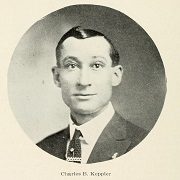
Charles B. Keppler, Chief Deputy to Sheriff John Patty of Greenlee County, was born in San Angelo, Texas, July 2, 1877. He was reared and educated in New Mexico, however, as the family removed there when Charles was but a small boy. His first occupation was mining and prospecting, which he followed in both New Mexico and Arizona, and in this State he has also been interested in ranching. Mr. Keppler came to Arizona and located in what is now Greenlee County, in 1893. In 1902 Sheriff Parks appointed him one of his deputies, and until 1908 he was thus employed, having during this time made a record that can scarcely be excelled for ability, keenness and perseverance. During the term of Sheriff English, Mr. Keppler returned to ranching, but when John D. Patty was elected Sheriff of the County, he appointed Mr. Keppler his chief deputy, despite the fact that Sheriff Patty was elected on the Republican ticket, and Mr. Keppler is a consistent Democrat. The appointment was made February 15, Statehood Day. One of the feats which has been notable in Deputy Sheriff Keppler's career is the trailing of the men who killed two deputies, the chase having included a large part of New Mexico before he succeeded in capturing them. He has practically been in charge of the field work In the county during this administration. Mr. Keppler is a member of the Eagles and the W. O. W. He was married April 14, 1913, to Miss Dona C. George, of Carlsbad, New Mexico, and they make their home in Clifton.
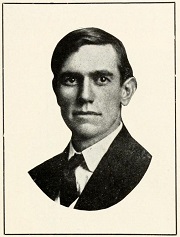
Joseph Wiley Aker, Superintendent of the Schools of Greenlee County, was born in Grant County, Va., July 7, 1881. His father, A. D. Aker, died the next year, leaving five children who were soon forced to support and educate themselves with the aid of a devoted mother. Their efforts in this respect have been well rewarded, as two of his brothers are successful ministers and the remaining one a teacher. Their only sister died at an early age. When but 17 years old, Wiley Aker joined the 4th Tennessee Volunteers and spent four months in active service in Cuba. Having been mustered out he returned to his home, and proceeded to the coal fields of West Virginia, where he was employed until in 1901 in a wreck he lost his right hand and right foot. The following September he began attending school at Princeton, W. Va., continued studying and in 1906 was graduated with a B. S. degree from Emory & Henry College. He next went to Lordsburg, N. M., where he served three years as minister of the M. E. Church, and was married to Rae Miller, a music teacher of that town. In 1909 he took charge of the M. E. Church at Clifton, Arizona, and when Greenlee County was organized in 1910, he was elected to the position he now holds, when he resigned his work in the ministry. For the present term he was elected by a large majority. Mr. Aker helped make the first school law of the State, and at a meeting of school officials at Tucson in 1912 was made a member of the committee to get up a course in moral instruction for the pupils of the State. Mr. Aker is deeply interested in school work. He is also author of several short stories, and one book of fiction, which is now in course of publication in New York City. His family consists of three sons, Malcome M., Cecil E. and Greenlee M. Mr. and Mrs. Aker are interested workers in all church and educational affairs.
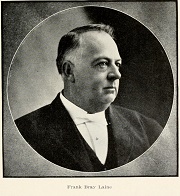
Frank Bray Laine, Judge of the Superior Court of Greenlee County, came of a line of distinguished jurists. His father, Thomas Henry Laine, was one of the ablest attorneys in California. He was a member of the Constitutional Convention of California in 1879, and the Constitution of the State was drafted largely from one written by him and submitted to the Convention. He was also a member of the State Senate in the 20th and 21st Legislatures and was active in behalf of progressive legislation. An orator of much ability, he was a potent factor in the Democratic party and an influence in the national politics of that day. He was also prominent in the Masonic order, and his son, Judge Laine, has kept the family name on the records of this order in a most commendable manner. The Laine family has long been connected with the development of the country. Judge Laine's grandfather having been a pioneer bear hunter of Missouri. Judge Laine is a native of California, having been born in San Jose in 1861. He was educated in the public schools of the State and at Franklin Academy, a private school named in his honor. He studied law in the office of his father, the first classical graduate in the State, who was graduated from the University of the Pacific in 1858. Judge Laine has attained high honors in Masonry in both the York and Scottish Rites, having taken the 32nd degree. He is also a member of the Knights Templar; is Past Master of the Coronado Lodge No. 8 of Clifton, and in 1910 was appointed Grand Orator for the State Lodge. He is also interested in other fraternal organizations and is Past Exalted Ruler of the Clifton Lodge of Elks No. 1174. In his manner of dispensing justice, which has been highly commended for fairness and depth of knowledge, Judge Laine has shown the benefits derived from his thorough training in law. His eldest son, Thomas Henry Laine, is now a student in the office of Charles S. Wheeler, one of San Francisco's well known attorneys, and his other son, Harry Nicholas Laine, is taking a special course at Stanford University.
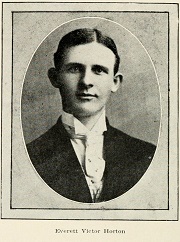
Everett Victor Horton, first County Attorney of Greenlee, has also the distinction of having been the first District Attorney of Greenlee County, upon its formation. He was elected to his present office by a large majority, principally because of the fine record he made while serving under the Territorial laws. He was born in Maxwell, Tennessee, in 1880, finished the common school course in that State, and then attended Burritt College, where he took the degree of B. S. He then taught school for several years, until he came to Arizona, in 1903. Here he was first connected with the Arizona Copper Company in a clerical position for three years, after which he returned to Tennessee and took a course in law in Vanderbilt University, Nashville. He received his diploma in 1907 and at once returned to Arizona, was admitted to practice, and, until he was elected one of the last officials of the Territory, was engaged in building up a substantial practice. Mr. Horton is a Democrat of the Progressive type, and has become well known over the State as an able attorney and a strong prosecutor. Among the notable cases he has handled are the famous cattle thieves' conviction, and the securing of a life sentence for the murderer who recently killed two Deputy Sheriffs of the County. Mr. Horton married Miss Katherine Jean Anderson, a native of Waverly, Tennessee, and to the union has been born one son, Edward. Mrs. Horton is a descendant of one of the old southern families, and with her husband takes a prominent part in the social life of their home town. Mr. Horton is a member of the Odd Fellows and Moose lodges.
John D. Patty, Sheriff of Greenlee County, was born in Columbia, S. C., in 1868. His parents were both natives of South Carolina, his father, Mark Patty, having been owner of a large flour mill for many years, and his mother was Hannah Cable Patty. Mr. Patty was educated in his native State and lived there until 1889, when he came to Arizona. Here he at once became associated with Wade Hampton in the cattle business and is still in partnership with him, being a member of the well-known Patty-Hampton Cattle Company. Before the organization of Greenlee County, while a resident of Graham County, Mr. Patty was appointed deputy to Sheriff Anderson, and was in charge of the eastern end of the county, and when division was made, he was elected Constable and made Deputy Sheriff, in which capacity he served in all five years. His record as peace officer was so high and his experience so broad that he had no difficulty whatever in securing the election to his present position, having been much in the lead of his ticket, and elected by a large majority over the incumbent at that time. Not only in a business and political way is Mr. Patty well known and popular, but in a fraternal way also, as he is a member of the Scottish Rite Masons, the Shrine, and the Elks. He was married December 22, 1912, to Mrs. Grace Kreuder, a native of Kansas.
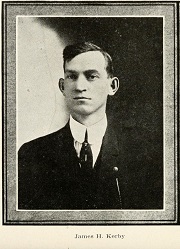
James H. Kerby, first Assessor of Greenlee County, was born in Huntsville, Mo., April 30, 1881. He is the youngest son of Cliff T. and Cassie Rutherford Kerby, whose parents were among the most prominent and influential residents of Missouri. His father died when James was but three years old, leaving a widow and five children, four boys and one girl. Mr. Kerby was reared upon a farm, and received only the advantage of a graded public school education. Not being satisfied with this, through his own efforts he completed a commercial course in one of the best schools of Quincy, Ill., after which he located in the City of St. Louis, where he was associated with William Seely, Circulation Manager of "The St. Louis Star," for about a year. Mr. Seely then left this position and became interested in the Seely-Van Dyke Drug Company, East Orange, N. J., took Mr. Kerby with him, and for more than a year he was in the employ of this company. Then, through correspondence with an old schoolmate who was located there, he came to Arizona and made his home in Clifton, arriving there in May, 1903. He first worked in the drug department of the A. C. Co., and then took a position as bookkeeper of the Cromb & Shannon meat market. In 1905 he returned to Missouri and was married to Miss Cora Gibson, daughter of George D. and Emilio Gibson, one of the prominent families of Howard County, of which her father served as Sheriff for twelve years. On his return, however, he became dissatisfied with working for a salary, and started for himself in the real estate business. He was deputy to Assessor John J. Birdno from 1907 to 1911 in Graham County, and because of his fair, impartial and fearless manner of assessing, and his knowledge of taxation, he earned the reputation of being one of the best officers who ever served the county in that capacity. In January, 1911, Greenlee County was organized from Graham, making necessary the appointment of an assessor for the new county. Certain interests fought the appointment of Mr. Kerby, but he secured the appointment. He started out with a valuation of $5,762,447.66, and at the end of the first year, though having worked at a disadvantage on account of not having maps or plats, the result w r as remarkable, as after the equalization was made it was found that the county's taxable wealth showed an increase of $1,409,421.92. In the fall of 1911, when county officers were elected, Mr. Kerby led his ticket in amount of votes received by any candidate having an opponent. His assessment for the year 1912 showed a more remarkable increase, for after the equalization was made it was found that the taxable wealth of the county amounted to more than $12,726,000.00, an increase over that of 1911 of more than $5,503,000.00, or a total increase of $6,993,562.34 for two years. Mr. Kerby became a member of the Arizona County Assessors' Association in 1911, when it was organized, and has done some wonderful work in having this association recommend tax measures to the legislature, among which is the repeal of the bullion tax law. It was his draft of the measure creating the Tax Commission that was adopted by the Attorney General, and at the time of the appointment of this commission Mr. Kerby was offered the position of Secretary, and after the resignation of one of the members was offered a place on the commission, which he refused because he was offered the short term instead of the one made vacant by the resignation. Mr. Kerby has the reputation of being one of the best informed men in the State on the subject of taxation, always interested in the equalization of assessments. He is a progressive Democrat, interested in working for the best interests of Democracy. He organized the first Democratic club in Greenlee County, and the fruits of its labors are to be noted at each election. Mr. Kerby is a member of Elks' Lodge No. 1174, and Coronado Masonic Lodge No. 8, F. & A. M., both of Clifton.
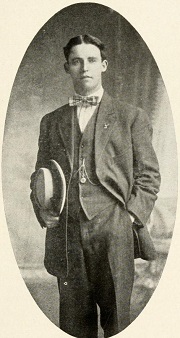
William E. Kelly, Recorder of Greenlee County, is the youngest county officer in Arizona, and one of the youngest in the United States, having been but twenty-two years of age when he assumed the duties of his present position. He is a native of Arizona, having been born in 1889 in Tombstone, where his parents, Michael and Julia Sullivan Kelly, were among the early settlers. He was educated in the public schools and at St. Michael's College, Santa Fe. Mr. Kelly has been thoroughly trained, and before election to his present position was chief book-keeper at the Shannon Copper Company's store, where he showed marked ability as an executive and accountant. His ability to capably fill the position of Recorder of Greenlee County w r as evidently recognized during the campaign, as he led the ticket and was elected by a very large majority. Mr. Kelly is a brother of J. J. Kelly, Assistant Cashier of the First National Bank of Clifton, and, like him, is a strong member of the progressive Democratic party in the State. Genial, courteous and popular, the people who have dealings with the Recorder's office speak in highest terms of the manner in which the records of the county are being kept, and of the treatment accorded them by the youngest county official in Arizona. Mr. Kelly is also well known in the social life of Greenlee County, and is popular in fraternal circles, being a member of the Knights of Columbus and Elks, and actively interested in the affairs of both orders.
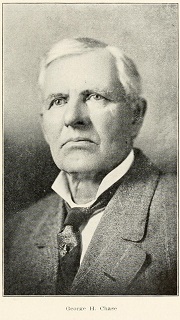
George H. Chase, Senator from Greenlee County, is a veteran of the Civil War, an absolutely reliable business man, an all around booster, and one of the most gentlemanly and substantial citizens of Arizona. He \vas born in New York in 1843, and has been a resident of this State since 1898.. While Senator Chase can hardly be classified as a pioneer, he comes of a line of pioneers and statesmen. His father, Samuel P. Chase, was a well known pioneer of that section of New York in which the Senator was born, and like his distinguished relative Salmon P. Chase, of national reputation, was known as a progressive, wide-awake citizen whose word was as good as his bond. Since coming to Arizona, Senator Chase has been actively engaged in its upbuilding, and when Arizona was ready for admission to the Lnion, the people of his county united in choosing him their first representative in the State Senate, regardless of their political belief, for, although they knew him to be a progressive Democrat, they also knew what manner of man he is. George H. Chase is a fighter and builder, and he has aided in many of the important building enterprises of the State, especially mining buildings of Clifton-Morenci district, which bear the stamp of approval of competent judges. Senator Chase is a Blue Lodge Mason of more than forty years' standing, and is a member of Winnebago Lodge No. 33, of Portage, Wisconsin. During the Civil War he served three years as cavalryman and was wounded three times, and left the service a Sergeant-Major with two commissions in his pocket, neither of which he accepted. Like his military record, his record since has been without blemish, the credit for which he is perfectly willing to share with Mrs. Chase, who is known throughout the Gila Valley as "Aunt Maggie," where she numbers her friends by her acquaintances, and her delight is in doing good. Mr. and Mrs. Chase are a splendid and interesting old couple, though George H. denies being old. They have two daughters and one son. At the first session of the Legislature Senator Chase was Chairman of the Committee on Mines and Mining and member of five other committees, and at the special session was Chairman of the Committee on Education and Public Institutions and member of Enrolling and Engrossing, Labor, Mines and Mining, Constitutional Amendments and Referendum, and Corporations Committees. When the First Legislature of Arizona has completed its work, there is no man whose record as a member will more readilv prove up under the searchlight than the "Gentleman from Greenlee," one of the staunch sort, of whom the State may well be proud.

Matthew H. Kane, member of the First State Legislature from Greenlee County, was born in Wisconsin March 4, 1869, and is the son of James and Anna Martin Kane. In 1873 his parents removed to Nebraska, then very sparsely settled, and there his childhood was spent with only Sioux Indians for playmates. From them he thoroughly learned their language and the expert use of the bow and arrow. For several years, up to the time he was eleven years of age, his time was spent herding cattle. From the time he was eleven years until he was twenty-one, he was employed as clerk, railway mail clerk, and traveling salesman. About that time he removed to Butte, Montana, where he became engaged in mercantile business, and there he was married in the year 1900. In 1901 he came to Arizona to accept the management of the store department of the Shannon Copper Company, which position he retained until the time of the convening of the First State Legislature. During the regular session Mr. Kane was Chairman of the Committee on Counties and County Affairs, and member of several others, and at the special session he was member of the Committee on State Institutions and Expenditures, known as the "Ax" Committee; also of the Cornmittee on State Accounting and Methods of Business, and Banking and Insurance, and Chairman of the Committee on Counties and County Affairs. On the adjournment of the regular session Mr. Kane purchased a ranch in the vicinity of York, to which he is now devoting his time.

H. D. Keppler, Deputy Sheriff of Greenlee County, was born July 12, 1859, in San Antonio, Texas. He is the son of Jacob Keppler and Anna Martha Ludwich, and a brother of Charles B. Keppler, Chief Deputy under Sheriff Patty of Greenlee County. His parents are both natives of Germany, but were married in San Antonio. Mr. Keppler was educated in the public schools of Texas, T vas first employed at farm work, and then drifted into mining in Dona Ana County, New Mexico. He came to Clifton, Arizona, February 18, 1885, and was first employed in the mines, but was shortly afterward appointed deputy sheriff, his first appointment having been under Billy Burchfield, of Graham County. He has now served more than twenty years in this capacity in Graham and Greenlee Counties. He was appointed for the present term by Sheriff John D. Patty, who places the question of party affiliation in a secondary position to that of fitness for the office, when one's ability and unusual qualifications have been proven beyond a doubt by years of service. Mr. Keppler has also served about eight years as Constable in Morenci. During all these years he has had some very exciting experinces while in the performance of his duty. He was in company with the deputies who were killed at Eagle Creek, twelve miles from Morenci, hut his horse fell crossing the river, causing Mr. Keppler to break his arm, and also to injure his leg. He was one of the participants in the fight in 1895 when two hold-up men were killed and one captured. Deputy Sheriff Keppler has taken part in all activities of peace officers since 1895. He was married April 13, 1907, to Mrs. Julia Smith, Their home is in Morenci.
Copyright © 1996- The USGenWeb® Project, AZGenWeb, Greenlee County